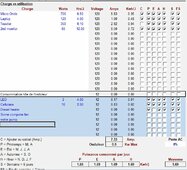JohnD0h
New Member
Look at the first post in page 2 to see what I'm looking for now! Thanks!
I'm in Canada.
First build this summer in a Volkswagen T4 long wheelbase, full time van-life, summer and cold winter.
I'm looking for cheap, simple as possible, NO solar panel, charge with EV public charger (7.2kW) and 48V car alternator, that I can also plug in camping site and 120V AC house.
Can I go now with 1x 48V 50Ah and add a second one later to help my budget build?
I need a 2000w inverter.
My van will be isolate and heat all the winter with a diesel heater.
Cooking and fridge will be on propane.
I don't want anything else than LiFePO4 Lithium Battery.
The 48v alternator will probably be a second alternator only for the 48v battery.
I'll probably use
NORJIN 48V 36V to 12V Step Down Transformer 360W 30A DC Voltage Converter with Fuse Waterproof Voltage Reducer Regulator for Truck Vehicle Car Boat Solar System from www.amazon.ca at CAD 36$ and free shipping.
I have access to
ECO-WORTHY 48V 50Ah Stackable LiFePO4 Battery from https://ca.eco-worthy.com/ for CAD 720$ with free shipping
and
Maple leaf 48v 100Ah Server Rack Beaver Deep Cycle Lithium Iron Phosphate Battery(LiFePO4 Battery) from https://solarpowerstore.ca/ look very similar to RUIXU.
and
LiTime 48V 100Ah Server Rack LiFePO4 Lithium Solar Battery from https://ca.litime.com/ with free shipping
and
RX-LFP48100 | 19" Rack Mounted 3U Module | UL1973 Certified | UL9540 pending from https://www.canada.ruixubattery.com/
All of 48V 100Ah are CAD 1800$
What do you think it's the best path for me?
Big thank to everyone that will help me doing it right the first time!
I'm in Canada.
First build this summer in a Volkswagen T4 long wheelbase, full time van-life, summer and cold winter.
I'm looking for cheap, simple as possible, NO solar panel, charge with EV public charger (7.2kW) and 48V car alternator, that I can also plug in camping site and 120V AC house.
Can I go now with 1x 48V 50Ah and add a second one later to help my budget build?
I need a 2000w inverter.
My van will be isolate and heat all the winter with a diesel heater.
Cooking and fridge will be on propane.
I don't want anything else than LiFePO4 Lithium Battery.
The 48v alternator will probably be a second alternator only for the 48v battery.
I'll probably use
NORJIN 48V 36V to 12V Step Down Transformer 360W 30A DC Voltage Converter with Fuse Waterproof Voltage Reducer Regulator for Truck Vehicle Car Boat Solar System from www.amazon.ca at CAD 36$ and free shipping.
I have access to
ECO-WORTHY 48V 50Ah Stackable LiFePO4 Battery from https://ca.eco-worthy.com/ for CAD 720$ with free shipping
and
Maple leaf 48v 100Ah Server Rack Beaver Deep Cycle Lithium Iron Phosphate Battery(LiFePO4 Battery) from https://solarpowerstore.ca/ look very similar to RUIXU.
and
LiTime 48V 100Ah Server Rack LiFePO4 Lithium Solar Battery from https://ca.litime.com/ with free shipping
and
RX-LFP48100 | 19" Rack Mounted 3U Module | UL1973 Certified | UL9540 pending from https://www.canada.ruixubattery.com/
All of 48V 100Ah are CAD 1800$
What do you think it's the best path for me?
Big thank to everyone that will help me doing it right the first time!
Last edited:




